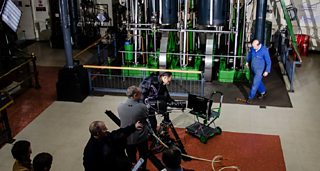Βι¶ΉΤΌΕΔ Research and Development: The Challenges of Filming High Frame Rate Video
Alia Sheikh
Technologist
Production Labs Shoot: High Frame Rate Capture for Βι¶ΉΤΌΕΔ Research & Development tests.
Hi,
I’m a filmmaker and R&D engineer at Βι¶ΉΤΌΕΔ Research and Development. I run the Production Labs project, creating bespoke production experiments to evaluate and improve novel software and hardware tools for Βι¶ΉΤΌΕΔ production environments.
One of my roles is to work with high frame rate and high dynamic range formats as required by our R&D projects. I produce and direct films that investigate the technical impact of these formats on production workflow as well as the pitfalls and possibilities they represent for creative storytelling.
The brief in this case was to film up to a minute of material (at 600 frames per second) which told a short but coherent story, incorporating various types of interesting motion. The result: a fight over a sandwich in an engine house.
As mentioned in our Μύ²Ή²Τ»εΜύ whitepapers "The frame and field rates that have been used for television since the 1930's cause problems for motion portrayal, which are increasingly evident on the large, high-resolution television displays that are now common. Βι¶ΉΤΌΕΔ Research and Development has been investigating the effect on human perception of material which is played back at higher frame rates."
This work is ongoing, and has included
Our is a fascinating study which takes into account human perception and the movements of the human eye when assessing the perception of motion in video.
This film at the top of this post shows the process of gathering high frame rate material for some tests Βι¶ΉΤΌΕΔ R&D did last year.
Television is currently transmitted at 50 fields (that is 50 interlaced half-frames) per second. For testing, we're interested in playing back exactly the same material at a variety of different frame rates (50 full frames per second, 100, 150, 200, 300 and even 600 frames per second).Β This means we need to capture this material at the highest of the frame rates we want to play back. Filming at even higher frame rates than these is commonplace for effects shots which are designed to be viewed in slow motion.
However it is incredibly rare for anyone to to attempt to film entire sequences at high frame rates, with the intention of playing those sequences back at full-speed. As shows, every aspect of the production is affected - from the huge amount of data we have to be able to handle, the amount of light we have to throw onto the scene and even how the crew interact with each other.
The results of this work were published in the Β and you can see behind-the-scenes photos from this shoot on this .

On location - see more pictures on Flickr
Photo by Peter Mills, Βι¶ΉΤΌΕΔ R&D
We’d be very interested in your comments on the possibilities of this work so please do leave them below.
Alia Sheilkh is an engineerΒ at Βι¶ΉΤΌΕΔ R&D
